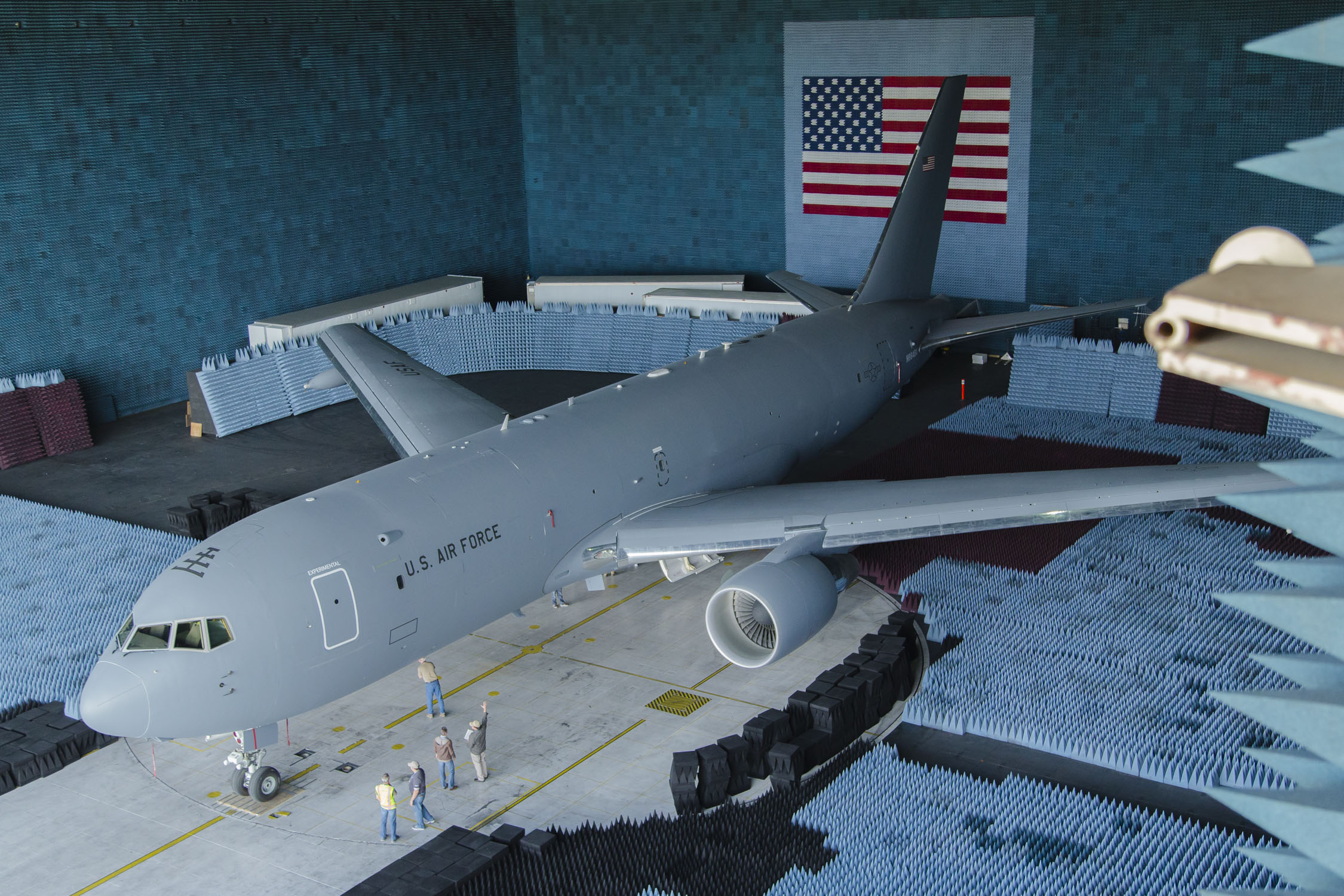
A KC-46 is loaded on the rotating platform at the Benefield Anechoic Facility for a series of avionics tests at Edwards AFB in May. Air Force photo by Christopher Okula
The Air Force is exploring three deficiencies on the KC-46 tanker, one of which is considered serious and could affect the jet’s ability to refuel stealth aircraft without compromising their low-observable features and thus their ability to complete their mission.
Service aerial tanker Program Executive Officer Brig. Gen. Donna Shipton said two of the deficiencies will likely be “closed” next month, but it’s “too early” to think about how the possible scraping of stealth aircraft by KC-46 refueling booms might be fixed.
This third deficiency involves “undetected contacts outside the receptacle,” meaning that the air refueling boom could hit the receiving aircraft away from the refueling receptacle without the boom operator knowing it. With the existing fleet of tankers, the boom operator gets an indication if the boom has touched the receiving aircraft in such a way, and procedures require him to inform the receiving aircrew. The receiver aircrew then “make the decision” whether this contact somehow “impacts” the jet’s ability to complete the mission, Shipton said.
The situation could result in stealth coatings being scraped off a receiving jet’s surface, compromising its low observability. KC-46 Program Manager Col. John Newberry said the situation “could have significant risk to aircrew.”
Shipton said “now that we’re aware of this,” the test force will work to “collect all the right data,” meaning a further series of tests next month. Only after the data has been collected and analyzed can a correction even be contemplated, she said. “We are concerned,” she said, and that’s why more testing is being done.
“The dimensions of potential fixes is premature to discuss at this point,” a top program official said, adding it’s too early to tell if the problem will further exacerbate the conclusion of developmental testing and the delivery of production aircraft.
Boeing insists it can achieve its requirement to complete development by the end of calendar 2017, but Shipton said the Air Force’s estimate is “Spring,” and when reminded the end of spring is June 20, she agreed “that’s what we’re thinking.” A senior program official said the KC-46 is “55 percent through flight testing,” and that some margin was “baked into” the schedule for “unknowns”—discoveries during the flight test that cause some delay.
Top Air Force uniformed acquisition chief Lt. Gen. Arnold Bunch told reporters at ASC17 it remains to be seen if the undetected contact issue is “a problem we can live with” or whether a corrective action is needed. The KC-46 has not, to date, made refueling connections with any stealth aircraft. Only the C-17, A-10, and F-16 have been tested in receiving mode.
The other two deficiencies, Shipton said, are not program-threatening. One has to do with the high frequency radios. Because they use the wings as antennae, HF radios must not broadcast during refueling operations, because there could be arcing and static electricity between the boom and receiver aircraft, Newberry explained. However, USAF can’t tell from tests so far if the HF radios, when turned off, stay turned off, even after various “failure modes.” An Air Force official said a more grave consequence could be “interference with flight controls.” Testing is supposed to be completed soon and the issue “closed out” in October, Shipton said.
The second problem involved the boom extending back out “uncommanded” even after it has disconnected from the receiver aircraft. This seems to be due to a spike of pressure inside the boom when fuel flow is abruptly halted, Shipton said. The situation was discovered in a ground test, when a boom poked back into a receiving test stand, striking it after an abrupt disconnect. This kind of thing is common in aerial refueling operations and isn’t a problem, Shipton said, providing the boom extension hits the refueling receptacle. Typically, “there’s no real danger” to either aircraft and “operators won’t even know” such an event has happened, she said. However, the Air Force is testing to see if there could be issues if the receiving jet is “off to the right or left” and outside the “outer edges of the envelope.”
Shipton said USAF’s estimate that Boeing will be about six months late ,concluding development is “not keyed” to the three deficiencies she discussed Friday, but rather because of delays in receiving amended and supplemental certifications for the KC-46 from the FAA. Because the jet is viewed as a commercial aircraft derivative, it must clear civil checks before military certifications can be granted.
She also said, while Boeing’s “estimate at completion” of development is $5.9 billion, the Air Force’s figure is $6.3 billion. Boeing is responsible for all costs above the contractual $4.9 billion cap under the fixed-price contract. If the aircraft already delivered must be modified to meet original specifications, Boeing will pay for that work. If the fix goes beyond something contained in the contract, the Air Force will absorb the cost of modifications. There are 24 KC-46s on contract and six are flying. Shipton said she sees no reason why a fourth production lot contract can’t be inked on time in January. Newberry said the cost was set in 2011, and so isn’t a matter of negotiation.